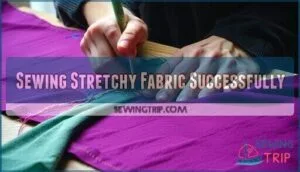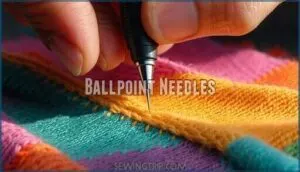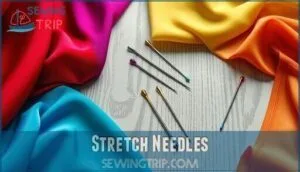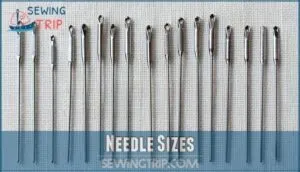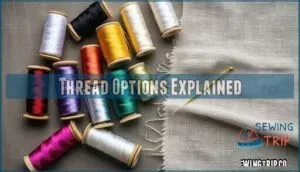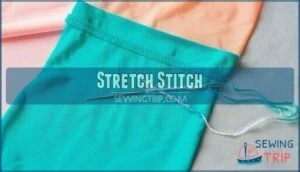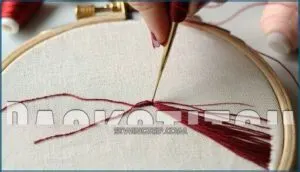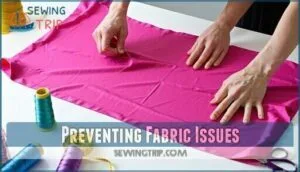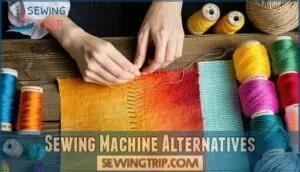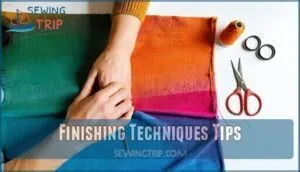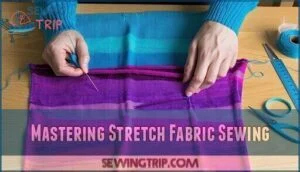This site is supported by our readers. We may earn a commission, at no cost to you, if you purchase through links.
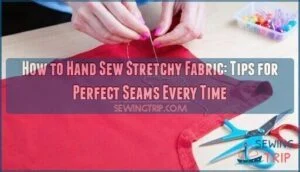
Start with a ballpoint needle that slides between fibers instead of piercing them. Use polyester thread for flexibility – cotton thread snaps under stress.
Don’t stretch the fabric while sewing; let it lie naturally. Choose a narrow zigzag stitch or backstitch with loose tension.
Test your technique on scraps first, because stretchy fabrics can be as unpredictable as weather forecasts. Keep your stitches consistent but not tight, allowing the seam to move with the fabric’s natural give.
Master these basics, and you’ll discover advanced techniques that transform challenging projects into satisfying successes.
Table Of Contents
- Key Takeaways
- Hand Sewing Stretchy Fabric
- Sewing Stretchy Fabric Successfully
- Fabric Selection Matters
- Needle Selection Guide
- Thread Options Explained
- Stitch Selection Techniques
- Preventing Fabric Issues
- Sewing Machine Alternatives
- Finishing Techniques Tips
- Mastering Stretch Fabric Sewing
- Frequently Asked Questions (FAQs)
- Conclusion
Key Takeaways
- You’ll need a ballpoint needle and polyester thread – the needle’s rounded tip slides between fibers without tearing, while polyester thread provides the flexibility that cotton thread lacks.
- Don’t stretch the fabric while sewing; let it lie naturally and use a narrow zigzag stitch or backstitch with loose tension to allow the seam to move with the fabric’s natural give.
- Test your technique on fabric scraps first since stretchy fabrics can be unpredictable – this prevents costly mistakes on your actual project and helps you adjust tension and stitch length.
- Prepare your fabric properly by prewashing to manage shrinkage, stabilizing edges with starch or tape to prevent curling, and using sharp scissors for precise cutting without distortion.
Hand Sewing Stretchy Fabric
Hand sewing stretchy fabric might seem tricky, but with the right tools and techniques, it’s completely manageable.
By choosing the proper needle, thread, and preparation methods, you’ll create strong, flexible seams that last.
Choosing Right Needle
When hand sewing stretchy fabric, choosing the right needle is vital.
A ballpoint needle for knits glides between fibers without tearing, thanks to its rounded point shape.
Match the needle size to your fabric thickness—smaller for lightweight, larger for thicker materials.
You can find a variety of options online.
Using a stretch fabric needle guarantees smooth stitching and prevents skipped stitches, making hand sewing knit fabrics easier.
Selecting Correct Thread
When sewing stretchy fabric, pick a thread that matches the fabric’s elasticity.
Polyester thread is your go-to for flexibility, while elastic thread works for extra stretch but needs careful handling.
Consider the thread’s give and pliability for best results.
Match thread weight to fabric thickness, and always consider fiber content.
For a polished look, color matching is key.
Specialty threads like woolly nylon add softness to hand stitching.
Preparing Fabric
Before hand stitching stretch fabric, fabric preparation is key.
Start by prewashing to manage shrinkage allowance—no one wants surprises later!
Lay it flat to dry, avoiding distortion.
Use sharp scissors for precise cutting techniques, and stabilize edges with starch or tape to prevent curling.
Marking methods like washable pens guarantee accuracy without damaging the fabric.
Careful handling saves headaches, and using techniques like these can prevent distortion and ensure precise cutting.
Sewing Stretchy Fabric Successfully
When sewing stretchy fabric, mastering tension control is key. Too tight, and your stitches may snap; too loose, and the seams won’t hold.
Adjust your stitch length to match the fabric’s elasticity—longer stitches work better for thicker materials. Always sew along the fabric grain to maintain its natural stretch and avoid distortion.
For hand sewing stretchy fabric, use a zigzag or stretch stitch to allow flexibility in the seam. Secure edges with neat seam finishes to prevent fraying or curling.
Don’t forget to test your stitch on a scrap piece first—it saves headaches later. Pattern adjustments may also be necessary to account for the fabric’s stretch.
With these sewing techniques for stretch fabric, you’ll achieve durable, professional results.
Fabric Selection Matters
Choosing the right fabric is the first step to sewing stretchy materials successfully.
Pay attention to stretch percentage, direction, and type to guarantee your seams hold up and the fabric moves as intended.
Stretch Percentage
When sewing stretchy fabric, understanding stretch percentage is key.
Stretch grades show how much fabric extends, impacting fit and flexibility.
To measure stretch, pull a 4-inch section; if it stretches to 6 inches, that’s 50%.
Consider fabric recovery too—how well it snaps back.
Matching percentage impact to your project’s intended use guarantees smooth hand stitching and lasting seams.
Stretch Direction
Understanding stretch direction is key for smooth hand stitching.
Two-way stretch fabrics move in one direction, while four-way stretch extends both ways, affecting stretch recovery and seam durability.
Bias-cut sewing shifts the grain line impact, adding flexibility but requiring careful needle and thread choices to avoid puckering or distortion.
Align your hand sewing techniques with the fabric’s stretch direction to ensure a smooth and durable finish.
Fabric Types
Choosing the right stretch fabric makes hand stitching easier.
Here’s a quick guide:
- Knit Fabrics: Soft and stretchy, perfect for t-shirts and dresses.
- Spandex Blends: Great for activewear, offering flexibility and durability.
- Jersey Varieties: Lightweight with 4-way stretch, ideal for comfy garments.
Consider fabric weight and stretch direction to match your project’s needs.
Needle Selection Guide
Choosing the right needle is key to sewing stretchy fabric without frustration.
You’ll want to focus on ballpoint or stretch needles, as their rounded tips prevent snags and guarantee smooth stitching.
Ballpoint Needles
A ballpoint needle is your best friend for sewing stretchy fabric.
Its rounded tip glides between fibers, preventing snags.
Ideal for knits, it guarantees smooth hand stitching without damaging the material.
Match needle sizes to fabric thickness for better results.
Regular maintenance tips, like keeping needles clean, extend their life.
Brands differ, so compare for the best fabric compatibility.
Stretch Needles
Stretch needles are your go-to for sewing stretchy fabric.
Their rounded tips, like ballpoint tips, glide through fibers without causing fabric snagging.
Many come with special needle coatings, reducing friction for smoother hand stitching.
Popular needle brands offer various options, so match the needle size to your stretch fabric’s weight.
A stretch needle guarantees clean seams and happy stitching!
Needle Sizes
When sewing stretchy fabric, needle size matters.
Match the needle to your fabric thickness—finer needles, like 70/10, suit delicate fabrics, while sturdier ones, like 90/14, handle thicker materials.
For hand sewing, ballpoint needles slide smoothly through fibers without snagging.
Pair the needle size with your thread size for balanced hand stitching and strong, flexible seams.
Thread Options Explained
Choosing the right thread is essential for sewing stretchy fabric by hand, as it affects seam strength and flexibility.
Polyester, nylon, and elastic threads each bring unique benefits, so understanding their characteristics helps you pick the best option for your project, considering the importance of flexibility.
Polyester Thread
Polyester thread works wonders for sewing stretchy fabric, thanks to its durability and slight elasticity.
Its strength prevents snapping during hand stitching, even under tension. Choose a thread weight that blends well with your fabric, ensuring smooth seams.
Don’t skip color matching—it keeps your project looking polished. Special finishes on polyester threads also help them glide effortlessly through stretch fabric, which is a key factor in achieving a professional look with slight elasticity.
Nylon Thread
Nylon thread is a game-changer for sewing stretchy fabric.
It’s strong, flexible, and resists snapping, making it perfect for hand sewing.
Here are five tips:
- Choose durable nylon thread for lasting seams.
- Use color options matching your fabric.
- Knot securely for strength.
- Ideal for sewing applications needing stretch.
- Test thread durability with fabric before starting.
These tips will help you achieve professional-looking results with durable nylon thread.
Elastic Thread
While nylon offers decent stretch, elastic thread takes flexibility to the next level.
You’ll find this specialized thread perfect for gathering and shirring techniques on stretchy fabrics.
Hand-wind your bobbin to prevent overstretching, then adjust tension settings for maximum elasticity.
This thread excels at waistbands and ruffles but isn’t suitable for structural seams requiring long-term durability.
Stitch Selection Techniques
You’ll need to choose stitches that move with your stretchy fabric instead of fighting against it.
The right stitch prevents seams from popping when you stretch the fabric, while the wrong one creates broken threads and puckered seams.
Zigzag Stitch
Flexibility makes zigzag stitch your best friend when hand sewing stretchy fabrics.
This versatile technique creates seams that move with your fabric instead of fighting against it.
Your tension settings need gentle adjustment to prevent puckering.
- Stitch width – Keep it narrow for delicate fabrics, wider for heavy knits
- Stitch length – Match your fabric’s stretch with shorter stitches for control
- Applications – Perfect for seams, hems, and edge finishing on stretch materials
- Hand sewing tips – Practice consistent spacing between stitches for professional results
Stretch Stitch
The stretch stitch resembles a lightning bolt and offers superior stitch elasticity compared to zigzag options.
This narrow pattern provides excellent seam strength while maintaining flexibility for hand application.
When sewing stretchy fabrics, adjust your needle tension carefully to prevent puckering.
Practice different stitch variations on fabric scraps first, as this technique works beautifully across various stretch fabric weights and types.
Backstitch
Backstitch creates rock-solid hand-sewn seams that won’t pop when your stretch fabric gets tugged.
You’ll work from right to left, inserting your needle one stitch length behind where your thread exits. This creates overlapping stitches that distribute stress evenly across the seam, making it perfect for high-tension areas.
- Picture your needle dancing backwards like a moonwalker on fabric
- Imagine building a chain of interlocking loops that won’t break under pressure
- Visualize creating tiny railroad tracks that keep your seam perfectly aligned
- Think of weaving a safety net that catches stress before it tears your project
Preventing Fabric Issues
You’ll face three main problems when hand sewing stretchy fabric: edges that curl up, fabric that shifts around, and bunching that creates uneven seams.
Learning to control these issues before you start sewing will save you time and create professional-looking results, by mastering the skills to overcome stretchy fabric challenges.
Preventing Curling
Curling edges can turn your stretch fabric project into a wrestling match.
Combat fabric curling with starchy sprays applied to problem areas before cutting. Use pressing techniques with a warm iron to flatten stubborn edges, or try fabric weights during layout.
Edge stabilization through light interfacing options helps maintain control. These sewing techniques prevent curling while preserving your hand sewing stitches and seams, ensuring complete concepts are applied to achieve the desired result.
Stabilizing Fabric
Taming unruly stretch fabric requires the right stabilizer to prevent unwanted movement.
Apply fabric stiffener spray evenly across your material, or use cut-away stabilizer for extra support. Starch application helps control edge curling while maintaining fabric stability.
For those seeking such products, consider browsing a fabric stiffener spray selection.
Choose backing fabric that matches your project’s stretch requirements. Proper tension control guarantees your stabilizer works effectively without restricting natural fabric movement, ensuring the right amount of support.
Reducing Bunching
Beyond stabilizing your fabric, you’ll need smart moves to prevent bunching during hand sewing.
Fabric bunching turns smooth seams into wrinkled disasters.
Keep your hand placement steady while maintaining consistent sewing tension throughout each stitch.
This control prevents seam puckering that ruins your project’s professional appearance.
- Control tension by keeping gentle, even pressure on your stretch fabric while stitching
- Use shorter stitch length to maintain better control over fabric movement and positioning
- Apply fabric stabilizers like spray starch to problem areas before starting your seam work
- Master pinning techniques by placing pins perpendicular to seam lines for maximum stability
- Practice consistent hand placement positioning to develop muscle memory for smooth sewing rhythm
To achieve a professional finish, it’s essential to combine these techniques with patience and consistent practice.
Sewing Machine Alternatives
When you don’t have a sewing machine or prefer working by hand, you can still create professional-looking seams on stretchy fabrics with the right techniques.
Hand sewing gives you complete control over tension and stitch placement, while sergers and special machine attachments offer additional options for handling elastic materials.
Hand Sewing Benefits
Nothing beats hand sewing stretch fabric when you’re seeking portability and creative control.
This cost-effective sewing technique transforms any quiet moment into therapeutic sewing practice, whether you’re traveling or relaxing at home.
Hand sewing offers complete accessibility – no electrical outlets required.
You’ll develop superior sewing skills through this traditional method, gaining intimate understanding of fabric behavior and stitch tension.
Serger Techniques
A serger transforms stretch fabric sewing into a breeze.
Proper serger setup with ballpoint needles prevents snags, while differential feed controls fabric stretching during stitching.
You’ll master rolled hems for lightweight knits and flatlocking seams for activewear.
Decorative serging adds professional touches to necklines and edges.
These stretch fabric techniques create durable, flexible seams that move with your garment naturally.
Sewing Machine Attachments
Your sewing machine becomes a stretch fabric wizard with the right attachments.
A walking foot prevents fabric from shifting while maintaining even tension. The rolled hem foot creates professional finishes on lightweight knits.
For gathering, use a gathering foot to control fullness. A bias binder attachment handles curved edges perfectly.
These presser foot upgrades transform tricky stretchy projects into manageable tasks.
Finishing Techniques Tips
You’ve finished your stretchy fabric seams, but proper finishing techniques turn amateur work into professional-looking results.
These final steps secure your threads, clean up loose ends, and press your seams flat so your garment maintains its shape and durability through wear and washing.
Securing Threads
After completing your seams, you’ll need proper knotting techniques to prevent unraveling.
Create invisible knots by pulling thread through the fabric’s underside, then loop back through itself.
For reinforcement stitches, use securing backstitch methods that lock thread tails firmly.
Different knot types work better with various sewing thread weights, giving you complete hand sewing control over your stretchy fabric projects.
Trimming Excess
After completing your seams on stretch fabric, you’ll notice thread tails everywhere.
Trim these close to the fabric, leaving about 1/8 inch for security.
Focus on bulk reduction around curved seams by cutting excess seam allowance at angles.
This creates neat finishes without compromising stretch.
Sharp scissors work best for clean cuts on stretchy fabrics.
Pressing Seams
You’ll want to press your seams carefully when sewing stretchy fabrics.
Use pressing cloths to protect delicate stretch fabric from direct heat damage.
Set your iron temperature low and avoid dragging motions that could distort seam finishes.
Light steam usage helps flatten seams without stretching.
Press gently to prevent stretching while achieving professional-looking results on your sewing fabric.
Mastering Stretch Fabric Sewing
You’ll transform your stretchy fabric projects from frustrating tangles into smooth, professional seams once you master these essential hand-sewing techniques.
Practice makes perfect when working with jersey, spandex, and knit materials, so don’t get discouraged if your first attempts aren’t flawless.
Practice Exercises
Practice makes perfect when working with stretch fabric. Try these hands-on exercises: First, practice seam stretching on fabric scraps using different stitches.
Focus on tension control while maintaining stitch consistency. Next, master curve sewing by creating rounded seams.
Work on fabric handling techniques by sewing straight lines without bunching. These sewing tips will improve your stretch fabric techniques and best practices.
Common Mistakes
Even experienced sewers stumble when tackling stretch fabric.
You’ll face these common pitfalls that can derail your project. Learning to spot these mistakes early saves time and frustration.
- Tension Problems: Too tight thread creates puckering, while loose tension causes uneven seams and poor stitch formation
- Wrong Needle Choice: Regular needles snag fabric fibers, leading to runs and fabric distortion in delicate materials
- Thread Snapping: Cotton thread lacks elasticity, breaking under fabric stretch and creating weak seam points
Advanced Techniques
Twin needle techniques create professional finishes with perfectly spaced parallel stitches and zigzag backing.
Master invisible stitching by catching just a few fabric threads, preventing wavy seams through controlled stretch fabric tension.
Advanced darts require careful fabric manipulation to maintain elasticity.
Decorative seams using fagotting stitches add visual interest while preserving stretch.
These methods elevate your sewing with lycra and other stretchy fabrics.
Frequently Asked Questions (FAQs)
Is there a trick to sewing stretchy fabric?
Don’t put the cart before the horse when tackling stretchy fabric.
You’ll need ballpoint needles, polyester thread, and zigzag stitches.
Pre-wash your fabric, use light tension, and sew slowly to prevent puckering.
What is the best hand hem stitch for stretch fabric?
Use a catch stitch or blind hem stitch for stretch fabric hems.
These stitches create flexible, nearly invisible finishes that move with the fabric without breaking or puckering, maintaining the garment’s stretch and professional appearance.
Can you hand sew elastic waistbands effectively?
Practice makes perfect when hand sewing elastic waistbands. You’ll need a ballpoint needle, polyester thread, and zigzag stitches. Distribute elastic evenly, backstitch at stress points, and maintain consistent tension throughout.
How do you repair tears in stretchy fabric?
Small tears mend beautifully with matching thread and zigzag stitches.
Place fabric on a flat surface, gently pull edges together, then stitch across the tear using small, overlapping stitches for invisible repairs.
Whats the best way to attach zippers?
Threading a zipper through stretchy fabric is like taming a wild horse—it requires patience and the right technique.
First, stabilize your fabric edges with interfacing.
Then, baste the zipper in place before hand-stitching with small, secure backstitches.
How do you create buttonholes in stretch fabric?
Creating buttonholes in stretch fabric requires interfacing behind the area first.
Mark your buttonhole length, then sew tight zigzag stitches around the perimeter.
Cut carefully down the center using sharp scissors.
Can you hand sew activewear and swimwear?
Ninety percent of activewear contains spandex or elastane blends.
You can hand-sew activewear and swimwear using ballpoint needles, polyester thread, and zigzag stitches.
Pre-wash fabric and test stitches first for best results.
Conclusion
Like conquering a mountain peak, mastering how to hand sew stretchy fabric requires patience, practice, and the right tools.
You’ve learned to choose ballpoint needles, select flexible polyester thread, and use proper stitching techniques.
Don’t rush the process—take time to test different methods on fabric scraps.
With consistent practice, you’ll develop the confidence to tackle any stretchy material project.
Remember, every expert seamstress started exactly where you’re now, and your sewing journey has just begun.
- https://books.google.com/books?id=6i39zQEACAAJ
- https://www.wawak.com/thread/thread-by-use/elastic-stretch/?srsltid=AfmBOorP2Oekejk_6t1xtsXLXD4iXY8R2lWzc_sSjN2BJ5h6xIIy1YO_
- https://redrockthreads.com/collections/mettler-seraflex-elastic-thread?srsltid=AfmBOopcMiWyvM1-E9QH9QxuRNYGEk56FikzvXMVA91UdwW7FtCYugb9
- https://blog.fabrics-store.com/2024/10/30/tutorial-shirring-with-elastic-thread/
- https://www.moodfabrics.com/notions/threads/elastic-thread

